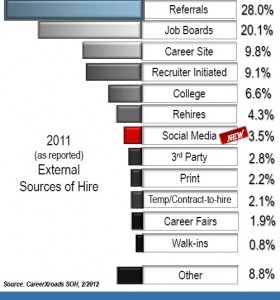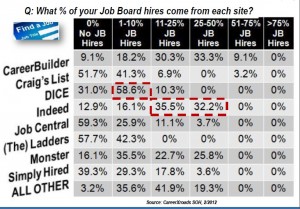After two years of looking internally to fill vacancies, companies in 2011 again began to hire new workers, relying on referrals and job boards for nearly 50 percent of their external hires.
Social media, though it accounted for only 3.5 percent of those external hires, evidences a much greater impact on hiring than the numbers would suggest, influencing candidates whose hiring ends up being attributed to other sources.
These are but a few of the findings in the just released 2012 CareerXroads Sources of Hire survey. Conducted now for a decade by the talent consultancy of Gerry Crispin and Mark Mehler, the annual survey queries the recruiting leaders of America’s largest companies about where they source the hires they make. Additional questions touch on emerging trends.
Nearly 60% of hires filled externally
While Crispin and Mehler caution that the results reflect only the hiring practices of the participating companies, the survey has come to be an industry standard, occupying the top Google results for “source of hire,” and is one of the tools recruiters use in developing their own recruiting strategy.
This year’s survey found that in 2011 the 36 participating companies, which collectively have 1.2 million employees, filled 59 percent of their 213,375 openings externally. It’s a dramatic change from the last two years when half the openings were filled by internal transfers and promotions.
 The 18.5 percent drop from 2010, says Crispin, “helps to confirm we are coming out of a recession. It confirms the data we’ve seen this last year.” Still far below 2007 when 72 percent of hires came from outside — “a very hot year,” he notes — it now “looks like we’re getting back to the historic balance.”
The 18.5 percent drop from 2010, says Crispin, “helps to confirm we are coming out of a recession. It confirms the data we’ve seen this last year.” Still far below 2007 when 72 percent of hires came from outside — “a very hot year,” he notes — it now “looks like we’re getting back to the historic balance.”
Where companies find their new workers hasn’t been changed by either the recession or the recent economic improvement. Referrals accounted for 28 percent of the external hires last year, a percentage largely unchanged over the years. As big a number as that is, it’s probably an undercount, says Crispin.
Somewhat more volatile — the likely result of more sophisticated tracking — is the percentage of hires coming from job boards. Last year, workers who first applied via a job board were 20.1 percent of the external hires.
Like the referral count, job boards almost certainly should be credited with a larger role in hiring.
“In many, maybe most, hiring, there are multiple influencers,” says Crispin. “The companies are getting better at tracking, but there are more things going on than are trackable.”
A few weeks ago, CareerXroads published a survey on employee referral practices, which suggested that referrals have a much greater impact than the direct counts suggest.
The impact of referrals
In the source of hire survey, Crispin and Mehler asked recruiting leaders their opinion on the influence of some recruiting channels. As they anticipated, referrals, social media, company career sites, and job boards (among other channels) are believed by the responding leaders to play reciprocal and influencing roles in the recruiting process.
“These are all underlying influencers. They don’t necessarily funnel candidates, but they help lead them to next steps,” says Cripsin, offering this scenario:
A job seeker goes to a job board and sees a job at a company where they previous worked. Now the job board has alerted somebody who used to work there. They go to the company site, because that’s where the posting sends them. But they call a friend who still works there, and the friend makes a referral, because the company pays a bonus.
The source of hire gets listed as ‘referral.’
A job board, says Crispin, “is really a lead; an alert. What do you do with an alert? You go back to the career (center) board.” So, he adds, even though the survey attributes 9.8 percent of the hires to company career sites, “most of them got there some other way. That’s why we asked about the influencers.”
Recruiting leaders told Crispin and Mehler that they believe social media, like job boards, plays a role in many of the sources of hire. For instance, 75 percent of the respondents say job boards influence the hires attributed to company career sites. Social media also exerts an influence on the career sites, say 62.5 percents of the respondents. And, as in Crispin’s scenario, career sites, social media, and job boards influence referrals.
The most effective job boards
Of the job boards the survey asked about, Indeed and CareerBuilder turned out to be the most effective. A third of the respondents said CareerBuilder yields between 25 and 50 percent of their job board hires; 9.1 percent said they get as many as 75 percent of their job board hires there.
 Indeed, which aggregates jobs from tens of thousands of sites, was every bit as strong a source of job board hires; 32.2 percent of the recruiting leaders reported the site yielded 25-50 percent of their job board hires. Cumulatively, just under 84 percent of the respondents said they got from 1-50 percent of their job board hires from Indeed.
Indeed, which aggregates jobs from tens of thousands of sites, was every bit as strong a source of job board hires; 32.2 percent of the recruiting leaders reported the site yielded 25-50 percent of their job board hires. Cumulatively, just under 84 percent of the respondents said they got from 1-50 percent of their job board hires from Indeed.
Dice, a niche site specializing in IT positions, was also a strong source of hires, with 58.6 percent of the companies filling up to 10 percent of their positions from Dice. Even Craigslist, a highly local listings site, was cited as a source of hire by nearly 50 percent of the respondents.
Many, perhaps even most, of the hires coming from job boards are the result of job seekers applying to ads. More than two-thirds of the respondents (68.6 percent) said more hires are made from postings than from resume searching. Only 5.7 percent said they make more hires by searching the resume database than by posting jobs.
That’s a significant difference from how recruiters use LinkedIn. There, searching profiles to source candidates has a greater impact than posting jobs, conducting marketing campaigns or company pages.
Tomorrow, part two of this report will focus on social media, intern hiring, and other recruiting influencers.
